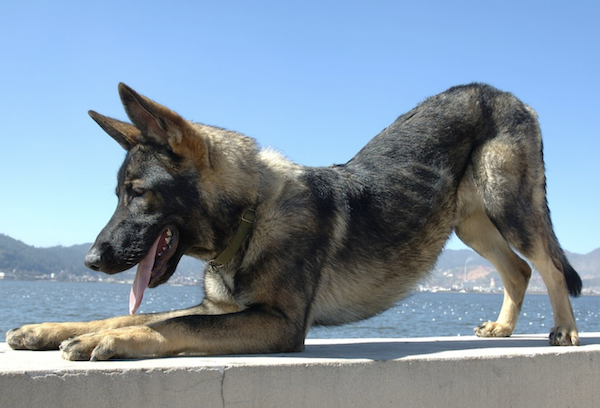
Occasionally on these pages, we’ll share what we know about a “breed” that we think is unknown to most of us. We leave it to readers to decide its “credentials” as an actual breed. NPDD isn’t always just about purebred dogs, it’s sometimes about what isn’t. See what you think.
We came across the Kunming Wolfdog dog only as a mention while reading about a United Nations Peacekeeping Force. Of course we wondered what it was, or even if it was a bona fide breed. We looked for more information and learned that two such dogs were sent from China in 2006 to a UN Peacekeeping Force to locate and detect landmines in Lebanon. The pair so successfully detected landmines that had been buried a foot deep that China’s Guangzhou Municipality requested the dogs to help with the 16th Asian Games held in 2010.
Impressive, but still we wondered: What is a Kunming Wolfdog?
The dog takes its name from Yunnan, a province in China where the “breed” was created in the mid 1950s for military service. The Chinese bred ten Beijing military “wolf dogs” (likely to be of German shepherd descent) with twenty tested local dogs (tested how, we don’t know), and then German Shepherd dogs from Germany. The resulting offspring were trained, and of the ninety dogs, the twenty best kept in the breeding program’s gene pool.
At first blush, the Kunming Wolfdog appears to be a very large German Shepherd Dog, but upon closer inspection, the Kunming has a far more powerful stance, in some measure because they stand taller in the back. They are, however, lighter than a GSD, have shorter hair, and their tails often curl high when excited. In terms of a work ethic, these dogs have been described as the wolf/dog version of G.I. Joe.
The Kunming Wolfdog was officially acknowledged as a breed by the Chinese Public Security Bureau in 1988, and the Chinese police force has been depending on them over the last five decades. That said, no registry that we know of recognizes it. Some dog experts don’t consider these dogs as a “breed” in the true context of the word, but a Google image search on “Kunming Wolfdog” brings up images that show consistency among the dogs, and presumably (and that’s a big presumption), it suggests breeding true for several decades.
So, what say you. purebred or not?
In closing, this past year (2019), China’s first cloned police dog finished her training in Yunnan Province and was officially accepted as a police dog on Thursday. She is Kunming Wolfdog, and you can read about her here. Science buffs can also read the abstract, “Signature of balancing selection at the MC1R gene in Kunming dog populations” here,
Image from Wikicommons shared under the terms of the GNU Free Documentation License.

Wayy to much worry about the term ‘purebred’. Function is always the most important thing in any hunting or working dog. I get so frustrated to see ‘beeds’ become a victim of inbreeding or loss of function because of too much emphasis on a singular look. I like genetic diversity, the wider the better while retaining function and a general look. That is one reason I admire the Estrela Mountain Dog which has an amazing degree of freedom of allowable coat, colors, size as long as soundness, physical ability, livestock protective nature is preserved
AS we are a purebred dog-centric website, John, our focus is necessarily on the breed AS a purebred dog, and that gives us the opportunity to discuss the breed in the first place. That said, we don’t feel that function precludes conformation, and indeed, one often leads to the other if one adheres to the “form follows” function school of thought.